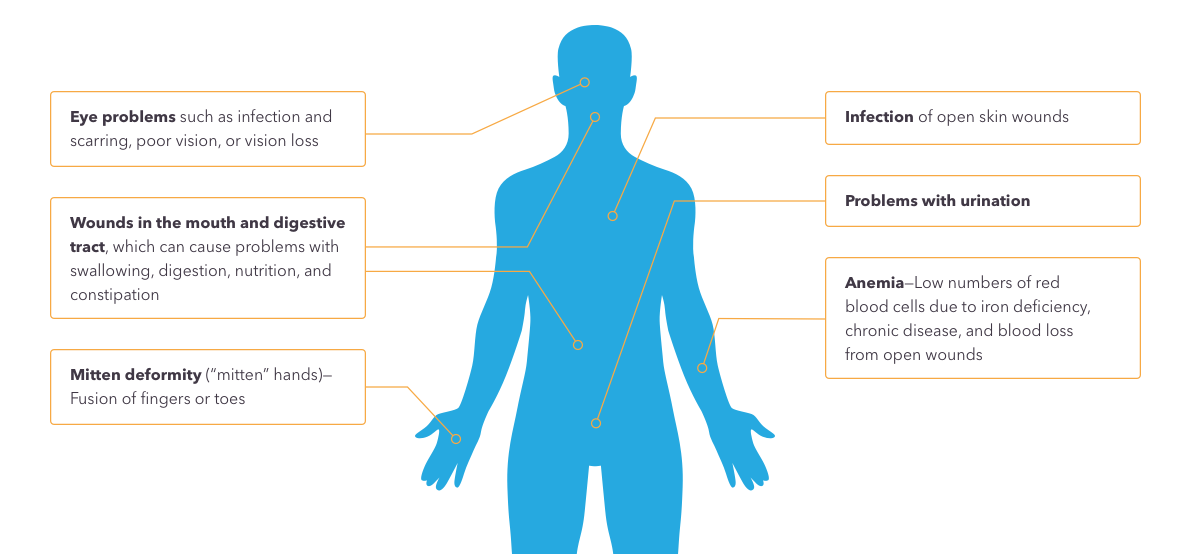An accurate dystrophic epidermolysis bullosa (DEB) diagnosis matters
Knowing if you or a loved one is living with DEB is critical to accurate care
A DEB diagnosis is the first step to appropriately manage symptoms and watch for risks and complications. It can also provide peace of mind and give you a clear view of what might come next while living with DEB. All DEB wounds should be taken seriously. It’s possible for any DEB wound, large or small, to develop complications, such as infections or even cancer.
DEB can have serious risks and complications that should be closely monitored
DEB can pose a serious cancer risk.
Lack of working type VII collagen (type 7 collagen) protein causes the outer and inner layers (the epidermis and dermis) of the skin to separate, causing blisters and wounds. Over time, DEB wounds are potentially at risk for developing an aggressive form of squamous cell cancer (SCC).
SCC is more common in people diagnosed with DEB than with other EB types.
An SCC can develop in any type of DEB wound, whether RDEB or DDEB. It can happen in wounds that are large or small, those that heal, and those that come back.
What is SCC?
Squamous cell cancer (SCC) is a serious form of skin cancer.
- It is the second most common form of skin cancer and is usually caused by sun damage or exposure to ultraviolet radiation
- SCCs can appear as scaly red patches; open sores; rough, thickened, or wart-like skin; or raised growths with a central depression
SCC in people living with DEB is different than SCC in the general population, which can be caused by sun damage.
Higher risk
People diagnosed with DEB are
more likely to get SCC than those
in the general population
Younger diagnosis
DEB patients are more likely to get SCC at a younger age, and the risk increases as they get older*
Multiple tumors
SCC in people living with DEB can be more aggressive, causing multiple tumors that can more easily spread beyond the skin
While all people with DEB are at risk for SCC, the risk is highest in people with RDEB.
*The median age at SCC diagnosis is 32.5 years in RDEB and 45 years in DDEB.
It’s important for people living with DEB to watch for and get screened for squamous cell cancer early and regularly.
DEB can affect more than the skin.
Blistering can affect epithelial tissues or the lining of organs inside the body in places like the mouth, throat, and intestines.
Eye problems such as infection and scarring, poor vision, or vision loss
Infection of open skin wounds
Wounds in the mouth and digestive tract, which can cause problems with swallowing, digestion, nutrition, and constipation
Problems with urination
Mitten deformity (“mitten” hands)—Fusion of fingers or toes
Anemia—Low numbers of red blood cells due to iron deficiency, chronic disease, and blood loss from open wounds

The burden of DEB can negatively affect a broad range of daily activities
- Interference with mobility (ability to move, bathe, eat, sleep, or participate in other physical activities like sports and exercise)
- Physical pain beyond what is caused by wounds
- Psychological burden, including feeling frustrated, embarrassed, worried/anxious, and/or depressed
- Barriers to socialization, such as the ability to make new friends
Active care from your healthcare team can help monitor or manage these problems.
There’s value in knowing if you or a loved one is living with DEB
Knowing if it’s DEB can help you or someone you love recognize the risks, get accurate care, and prepare for the future.
Proactive management
Your healthcare team can give more tailored and active care specific to DEB
Comprehensive and proactive risk monitoring
You and your healthcare team can closely watch for risks specific to DEB, including SCC and internal complications
A connected community
You can connect with other people and families who are living with DEB to share knowledge, experience, and support
Family planning
When planning for the future, a genetic counselor can discuss personalized family planning with you
A clearer future
You can find information and resources specific to DEB
If you or someone you love is living with DEB, it’s important to know you’re not alone.